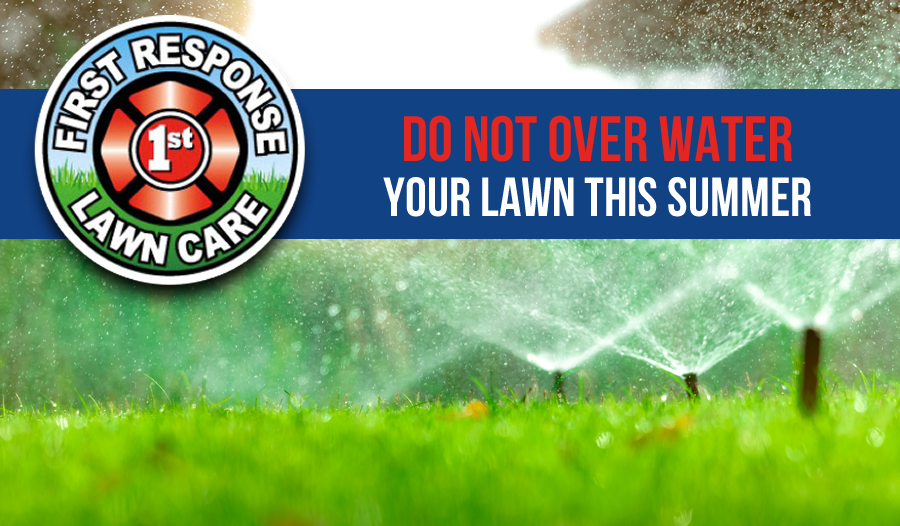
by admin | Jul 26, 2019 | Aeration, Irrigation Rockwall, Landscaping Rockwall, Lawn Aeration Rockwall, Lawn Care 101, Lawn Care Royse City, Lawn Diseases, Texas Summer Lawn Care Tips, Water Conservation, Watering
The most common lawn watering mistake that most homeowners make is they over water the lawn. It is much more damaging to over water a lawn versus under water a lawn. Over watering a lawn causes the soil to become anaerobic or absent of oxygen. Water replaces air in the soil and anaerobic soils become compacted, prevent deep digging grass roots, and will kill beneficial microbial activity.
Daily lawn watering is extremely damaging for a lawn. Daily lawn watering prevents the roots of the grass from growing deep into the soil. These shallow grass roots will make the lawn unable to stay green during the heat of the summer.
The best way to promote the grass’ roots to start digging deep into the soil is to water deeply and infrequently. After changing the lawn watering to the recommendations below, your lawn might look worse before it starts to look better. The lawn will start to look healthier as soon as the grass’ roots start digging deep into the soil.
The ideal time to water a lawn is early in the morning before sunrise. Our recommendation is to finish watering no later than 6:00 AM. If this is not possible then the next best time to water is late evening.When daytime high temperatures are hot and average above 85°F: Water no more than 3 days per week. This is typically between mid or late June through mid or late August. (e.g. Water every Monday, Wednesday, and Friday).
This lawn watering technique is a very deep watering, but it also allows the soil to completely dry out before the sprinkler system waters again. Organo-Lawn invented this lawn watering technique and it is universal worldwide.
Symptoms of an Over Watered Lawn
Some clear signs of over watering a lawn include: severely compacted soils, the presence of Necrotic Ring Spot lawn fungus, the abundance of insect pressure, mold, root rot, and a shallow root system. Over watering a lawn is much worse for the grass and trees than under watering a lawn because a lawn that is watered too much will starve the soil of oxygen. Air is extremely important to the health of the soil and to promote deep digging grass roots. Most of the time when we see a lawn watering problem in a Boulder or Fort Collins area lawn, we advise the customer that we need to adjust the lawn watering schedule in their lawn, they often assume we want to increase the amount of water. This might be true some of the time, but the majority of the time we end up reducing the frequency of days the lawn is being watered and increase the duration.
First Response Lawn Care can perform a sprinkler audit and set up the system to water according to our suggestions. The lawn is usually being watered deeper and less frequent. Most of the time, after we make our adjustments, the total water use is reduced which goes a long way towards water conservation. It’s a good thing for your lawn, for resources and for your pocketbook.
Call First Response Lawn Care (214) 701-7622 if you would like a sprinkler audit, sprinkler repair or need a new irrigation system in Rockwall, Fate, Royse City and surrounding areas!
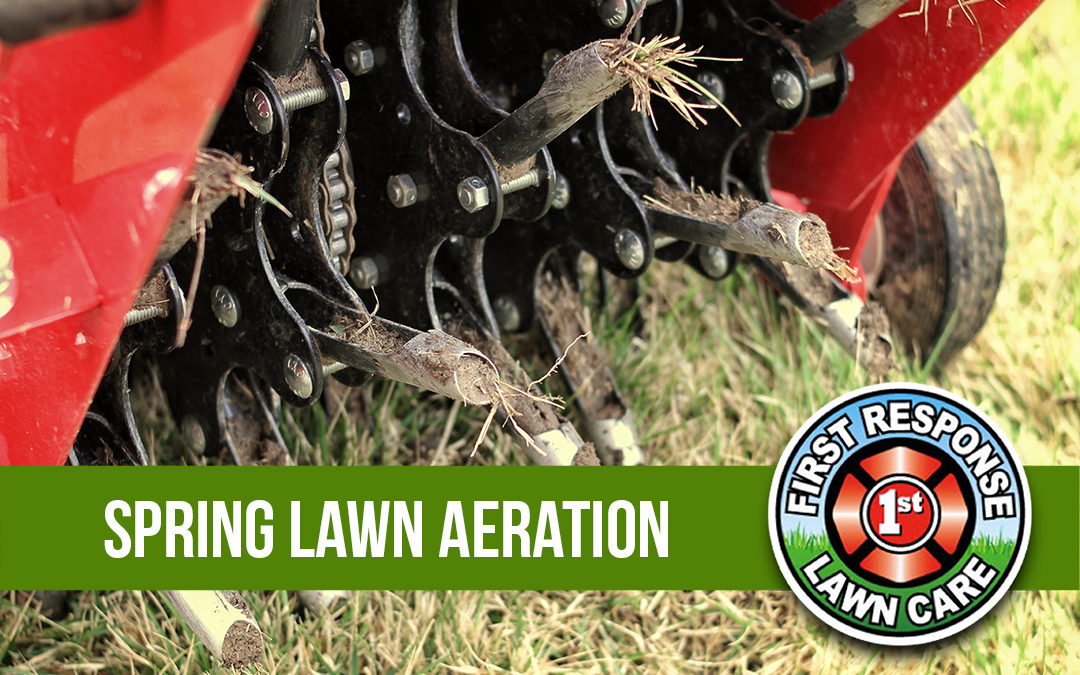
by admin | Apr 26, 2019 | Aeration, Spring Weed Control
SPRING LAWN AERATION SERVICE
If you are struggling to keep your lawn healthy, First Response Lawn Care lawn aeration service may be able to help.
Lawn aeration is important if you want your yard to look healthy and green. When your lawn is aerated, it allows the roots of the grass to go deeper in the ground and helps spread the seed better.
Our lawn aeration service in Fate TX and surrounding areas is just a phone call away at (214) 701-7622
A remedy for soil compaction
When you mow or simply walk on your yard, you compact the soil. This makes it impossible for the roots to grow deep. That means your yard is more likely to be torn up by rain and erosion or everyday use. Over time, soil compaction seals the top layers of the soil and creating run off of the irrigation water rather than allowing it to soak down into the roots of your lawn.
Aeration service breaks up the topsoil making it softer. This allows the roots of your grass to become deeper and stronger.
Get a FREE Estimate or Call Now – (214) 701-7622!
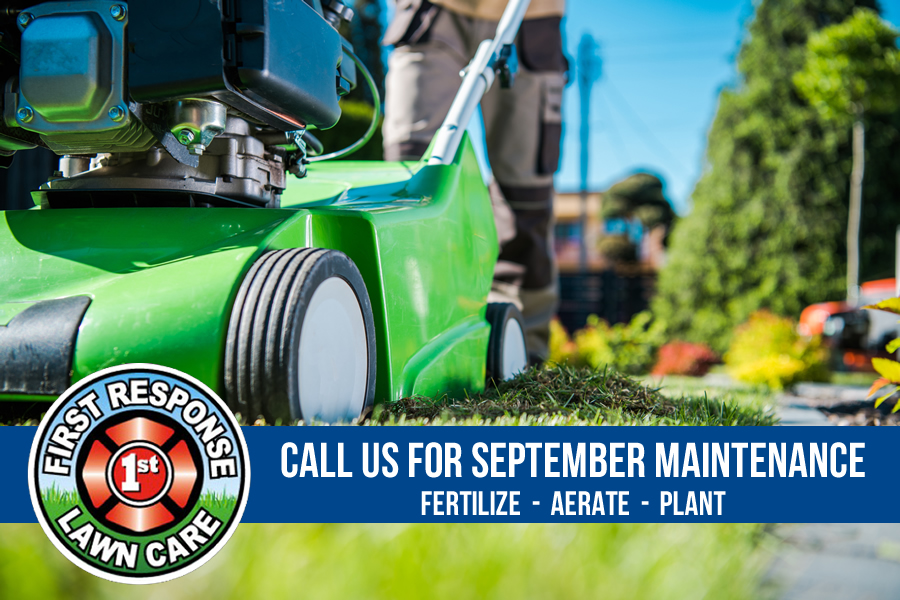
by admin | Sep 14, 2018 | Aeration, Fertilize Treatments Rockwall
September could very well be the best month of the year to fertilize your lawn. We know you’ve heard this before in other months, but this is THE MONTH for fertilization. Here are our top tips for September lawn maintenance in Texas.
Dethatch Your Lawn
A thin, half-inch layer of thatch is normal and healthy for a lawn, but thatch that’s deeper than 1 inch should be removed as it prevents air, light and water from reaching the turf’s root zone. As thatch accumulates, there is a tendency for root growth to occur primarily in the thatch layer rather than the soil. This may result in a weakened, poorly rooted turf that is prone to stress injury. Thatch also makes an excellent breeding ground for harmful insects and disease organisms. For more information about dethatching, call First Response Lawn Care at (214) 701-7622, your lawn care service provider in Rockwall, Caddo Mills, Royse City, Fate, Rowlett, Forney, Heath, Sachse, Wylie, Lavon, Garland and surrounding areas.
Plant
Plant St. Augustine sod by mid-month to allow time for deep root growth before the first freeze. Bermuda seed should also be sown no later than mid-September, but sod can be planted later in month, if needed.
Aerate Your Lawn
After detaching your lawn, it’s a good idea to follow through with aeration. Aerating your lawn allows more nutrients and water to reach the grass root zone. Fall is a great time to do it as grass plants are beginning to store food for next spring.
These are only a few things you can do during September to keep your lawn healthy and strong for the pending winter season.
Apply Pre-emergent Herbicide
Apply a pre-emergent herbicide in September to prevent winter grassy weeds such as annual bluegrass, rescue grass and rye. (Don’t use if you’re over-seeding your turf.) Gallery products prevent annual broad-leafed weeds.
Pre-emergents need to be applied before the weeds actually sprout and start growing. You can apply them on the same day, then water them both onto the soil’s surface at the same time, but do not try to mix them in the fertilizer spreader. Make two separate passes across the lawn.
First Response Lawn Care can take care of all your lawn care maintenance aeration, fertilization and more in Rockwall Texas and surrounding areas.

by admin | Sep 7, 2018 | Aeration, Fall Gardening in North Texas, Irrigation Rockwall, Mulch
In the fall when temperatures are more moderate, it’s a great time to perform lawn maintenance and prep. Here are some fall lawn tips for North Texas on how to cultivate the perfect lawn, and radiant flower beds here in Texas that will have you sitting back and relaxing with minimal regular maintenance.
Check Irrigation
Use water systems which are low profile to ensure you’re waste of water is minimal and that the plants receive the majority of it. Be cognizant of plants that require greater amounts of water than others, and try to group them in the same locations. Rather than frequency, aim for an increased length of time in watering. And, finally, ensure your equipment is properly cleaned, functioning, and covering all areas for which water is required. Efficiency increases effectiveness. If you need a checkup of your irrigation system, call First Response Lawn Care!
Mulch and Compost
The effective use of mulch and compost in your soil beds will go a long way toward providing the natural nutrients which are required by your plants, thereby reducing the need for extra fertilizer. They also help to reduce weed growth, and some organic mixes can increase water and oxygen retention as well as carbon-trapping. The best time for compost placement is in the spring, however, mulching can be done in the fall to help protect the root systems of your plants.
Prune
Prune with a purpose. Do not “top” any trees or shrubs including crape myrtles. Never leave stubs. Cut flush against remaining branches on shrubs and along the branch collar on trees. Peach and plum trees should be pruned to encourage horizontal branching, remove any strongly vertical shoots.
Continue to prune evergreen trees such as magnolias, live oaks, and wax myrtles to minimize possible ice damage. Re-shape evergreen shrubs and shade trees, as needed (even during dormant winter months).
Avoid pruning spring-flowering trees and shrubs during the fall, as pruning now will reduce spring flowers. Continue to cut back spent flowers of annuals and perennials to encourage fall blooming until first frost. Trim dead or damaged wood from trees and shrubs but best advice is to avoid drastic pruning.
If you need help with any of the above fall gardening prep, call First Response Lawn Care at (214) 701-7622!.
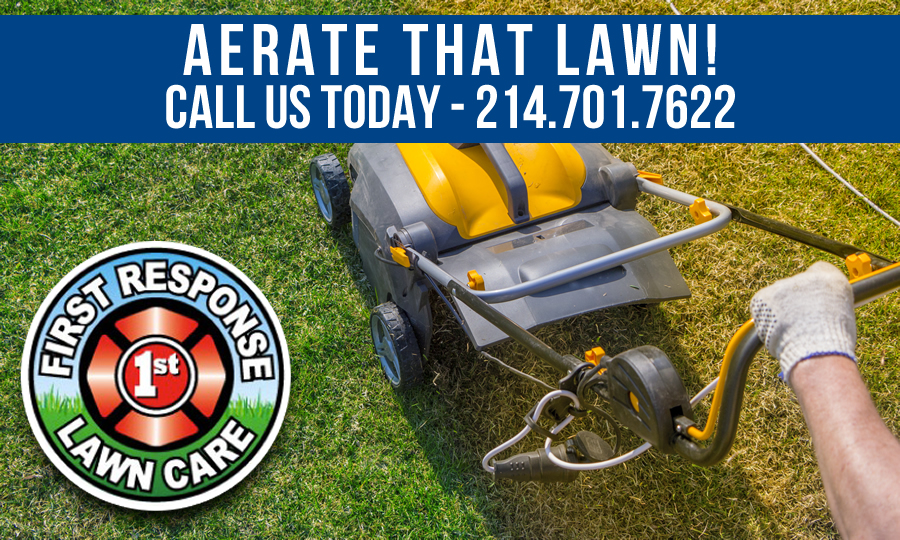
by admin | Aug 30, 2018 | Aeration
Regular maintenance tasks go a long way in creating a thicker, healthier lawn. But jobs typically reserved for once a year can play a significant role in supporting smaller steps taken across the months. Aerating lawns to relieve soil compaction and enhance grass growth is a regular annual task. Almost any lawn can benefit from aeration when it’s timed well and done properly.
Why Aerating Helps Lawns
Grass roots need air, water and nutrients to grow thick, deep and strong. When soil becomes compacted, even slightly, it inhibits the flow of the essentials that support thicker, healthier turf growth. A layer of compacted soil just 1/4 to 1/2 inches thick can make a significant difference in the health and beauty of your lawn. Aeration creates holes down into the soil to alleviate compaction so air, water and nutrients can reach grass roots.
Deprived of their basic needs by compacted soil, lawn grasses struggle in stressful situations, such as heat and low rainfall, and lose their healthy, rich color. Grasses gradually thin and eventually die out completely, for lack of the oxygen, water and nutrients available just inches away. Even a single aeration session can open the avenue for these essentials to reach their mark and put your lawn back on an upward trend.
When Lawns Need Aeration
It may not seem your lawn could get compacted, but it happens easier than you may think. Outdoor entertaining or yard play by kids and pets can leave all or part of your lawn compacted. Parts of Texas have heavy clay soil and annual aeration is needed to keep your lawn from becoming thin and weak.
Dethatching and aerating are two different tasks, but they often go hand in hand. Thatch is the layer of decomposing organic matter that forms right at the lawn surface, between soil and grass. When thatch gets more than 1/2 inch thick, it works like compaction to prevent the flow of air, water and nutrients grasses need. Aggressive spreading grasses, such as Kentucky bluegrass in northern lawns and Bermudagrass down south, form more thatch than many other grass types. Aeration helps penetrate and reduce thatch buildup or prep it for removal through dethatching.
If your grass often looks stressed and your soil is hard to the touch or rainwater puddles up where it used to be absorbed, you may have compaction problems. Confirm your suspicions with a simple “screwdriver test.” Take a regular screwdriver and stick it into your lawn’s soil by hand. It should slide in fairly easily. If you meet resistance, your soil is compacted, and aeration can help.
After your lawn is aerated, let soil plugs or extra soil dry where they fall. They’ll break down in rain or crumble the next time you mow, adding beneficial soil and organic matter to your lawn surface.
By adding aeration to your annual task list, you help ensure your lawn can reach its full potential for thickness, health and beauty. First Response Lawn Care is committed to providing you with the finest in grass seed and lawn care products to help you achieve your lawn goals.
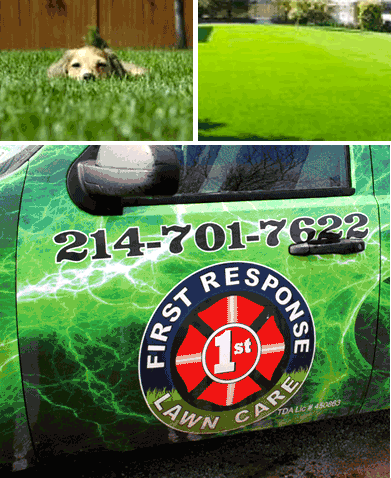
by admin | Aug 10, 2018 | Aeration
There is plenty to do in the lawn and garden in August. We have some recommendations for tasks around your yard this month.
Lawn Maintenance and Preparation
Prepare for fall grass seed planting by leveling low spots, removing weeds, and choosing your seed if it needs to be ordered in advance. First Response Lawn Care can help!
Lawn Aeration
Aerate your lawn and dethatch it. First Response Lawn Care offers lawn aeration services.
Lawn Fertilization
If there is plenty of rainfall, August is a good time to fertilize your lawn in preparation for Fall.
To help your grass beat the heat and reduce lawn maintenance, keep your lawn mower blade on the highest setting. Don’t worry if parts of your yard turn brown this time of year – it happens.
Annuals and Perennials
Spring and summer-flowering perennials can be divided and transplanted after blooming. In zones 5 and warmer: divide overgrown plants and discard the extra, or transplant during the coolest part of the day and preferably in the shade.
Trim and fertilize your containers – they still have time for another show.
Deal with late-season pests – such as aphids, whiteflies, and spider mites – with a spray of water from the hose.
Treat diseased plants, and remove diseased foliage before leaves drop.
Prune back vigorous climbers such as wisteria, and train them around trellises while the growth is soft.
Propagate plants by collecting seeds, taking cuttings, or layering.
Continue deadheading! For prolific bloomers like coreopsis and catmint, shear them lightly to encourage more blooms.
Label your plants with garden stakes, particularly perennials that die down to the ground in the fall.
If you need help with your lawn or garden maintenance, call First Response Lawn Care at
(214) 701-7622!






